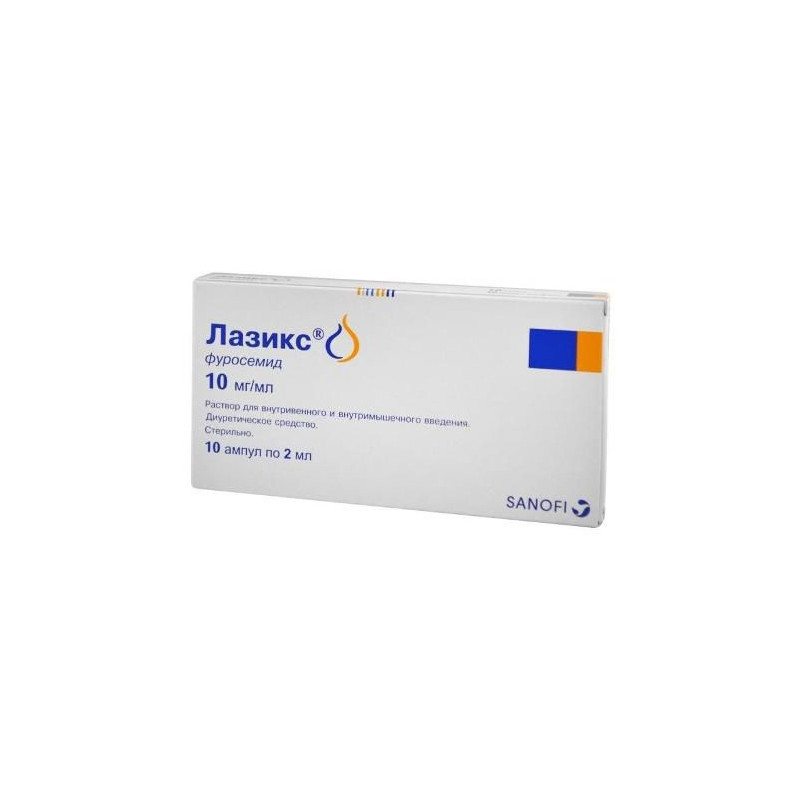



 All payments are encrypted via SSL
All payments are encrypted via SSL
 Full Refund if you haven't received your order
Full Refund if you haven't received your order
Lasix®
Pharmacological action - diuretic.
Blocks the reabsorption of sodium ions and chlorine in the ascending limb of the loop of Henle. Also increases the excretion of potassium, Calcium, Magnesium.
When ingestion bioavailability is 64%. Cmax increases with increasing dose, but the time to reach the maximum does not depend on the dose and varies widely depending on the patient's condition. T1/2 - about 2 hours. In plasma, 91–99% binds to protein, 2.4–4.1% is in a free state. Biotransformed mainly in glucuronide. Excreted in the urine (after the on / in the introduction of more than ingestion).
The onset of the diuretic effect on ingestion is observed already for 1 hour, the maximum of the action - after 1–2 hours, the duration - 6–8 hours. 2 hours. When i / v administration causes dilatation of the veins, quickly reduces preload, reduces pressure in the left ventricle and the pulmonary artery system, reduces systemic pressure.
Edematous syndrome of various genesis (cardiac, hepatic, renal after the second month of pregnancy, intoxication), pulmonary and brain edema, arterial hypertension, forced diuresis, renal failure.
Hypersensitivity (including to other sulfonamides and sulfanilamides), acute glomerulonephritis, renal failure with anuria, hepatic coma, impaired water-salt balance and KHS (hypokalemia, hyponatremia).
When pregnancy should be used under strict indications and only for a short time. At the time of treatment, breastfeeding should be suspended.
Hypotension, arrhythmia, dry mouth, nausea, vomiting, diarrhea, pancreatitis, hypovolemia, dehydration, hypokalemia, hyponatremia, chloropenia, metabolic alkalosis, hypocalcemia, hyperuricemia, dermatitis, impaired hearing, vision, paresthesia, dizziness, muscle weakness, urinary retention in patients with prostate adenoma, hypercholesterolemia, hypertriglyceridemia, decreased glucose tolerance, acute pancreatitis, allergic reactions (rash, fever, vasculitis, interstitial nephritis); in premature babies - nephrocalcinosis.
Increases the risk of intoxication with cardiac glycosides (in the presence of glucocorticoids, the likelihood of hypokalemia), nephro and ototoxic effects of aminoglycosides, cephalosporins, Cisplatin; enhances the effect of curare-like agents; increases lithium reabsorption in the renal tubules. NSAIDs reduce diuretic effect.
Inside, usually appointed on an empty stomach; IV is introduced for at least 1–2 minutes.With mild edema syndrome, the initial dose for adults is 20–80 mg when taken orally or 20–40 mg IV; in the case of persistent edema, the same or increasing dose of 20–40 mg (20 mg for parenteral administration) can be reappointed no earlier than after 6–8 hours (2 hours for parenteral administration) until a diuretic effect is obtained; This individually selected dosage can be applied 1 or 2 times a day. The greatest effectiveness is achieved when taking the drug 2-4 days a week. For children, the initial dosage is 2 mg / kg body weight (for parenteral administration, 1 mg / kg), with an unsatisfactory effect, it can be increased by 1-2 mg / kg (for parenteral administration, by 1 mg / kg), but not earlier. than 6–8 hours (for parenteral administration this period is not less than 2 hours). With hypertension, the initial dosage for adults is 80 mg per day in 2 divided doses. In case of pulmonary edema, Lasix is administered intravenously at a dose of 40 mg, if necessary, administration of the drug in a dose of 20 to 40 mg is possible after 20 minutes.
Consideration should be given to a possible decrease in the reaction rate (carefully designate when driving and maintaining machinery).
In the dark place at a temperature of no higher than 30 ° C.
Keep out of the reach of children.
